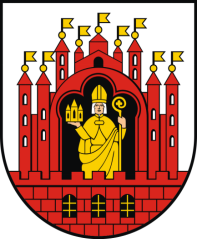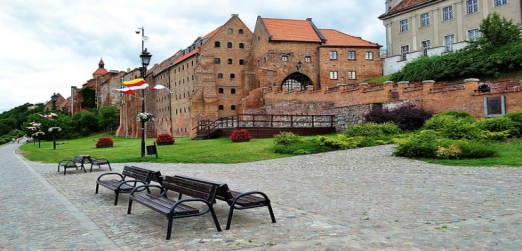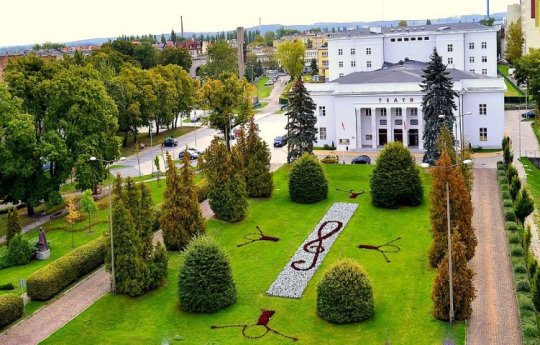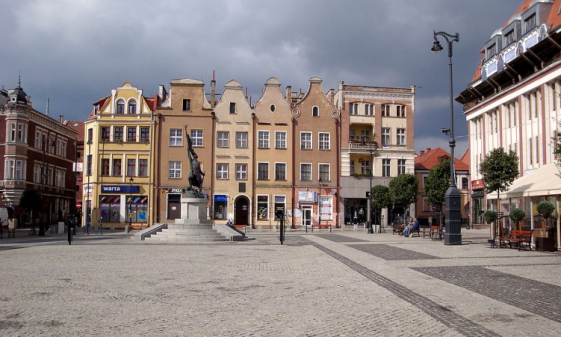Grudziądz- Kuyavian-Pomeranian Voivodeship 作者: 来源: 发布时间:2021-07-14
Ⅰ. Population and Area
Population (2018)
• Total 95,045 Decrease (40th)
Area
• Total 57.76 km2 (22.30 sq mi)
Website http://www.grudziadz.pl

Ⅱ.Natural Geography (environment and resources)
Grudziądz is located close to the east shore of river Vistula, approximately 22 kilometres (14 miles) north-east of Świecie, 93 km (58 mi) south of Gdańsk and 170 km (106 mi) south-west of Kaliningrad.
Location of the city
Location in the center of Poland makes Grudziądz an ideal place to locate investments that have their customers on the markets of both Western and Eastern Europe. The location 120 km south of the Baltic ports in Gdańsk and Gdynia, next to the A1 motorway (Gdańsk - Łódź) and at the intersection of important national roads connecting the eastern and western borders, is an undeniable advantage of the city. Grudziądz also has an interesting tourist location. Within a radius of 100 km there are many natural attractions and monuments, including those inscribed on the UNESCO list.
Transport accessibility Road transport:
● A1 motorway - Grudziądz junction and 3 other junctions within a 25 km radius ( Warlubie, Nowe Marzy, Lisewo),
● the S5 expressway under construction (Ostróda - Wrocław) - will run through the city,
● national road No. 91 (Gdańsk-Cieszyn) - 5 km,
● two national roads no. 55 and 16 crossing the city, are fragments of a transport corridor connecting the western and eastern border .
Railway transport:
Grudziądz is connected with the CE 65 main railway line running from Gdynia through Bydgoszcz, Łódź and Katowice to the western and southern borders, which is an element of the Trans-European Railway Freight Transport Network.
Sea transport:
Grudziądz has a motorway connection with the ports of the Gdańsk metropolis. Thanks to the intensively developed, modern port infrastructure in Gdańsk Gdynia, there are container terminals with a throughput capacity of 3 million TEU. The offer is complemented by two modern terminals for servicing ro-ro ships and three terminals for servicing passenger and car ferries. The network of shipping connections is also being expanded every year. The two non-freezing sea ports in Gdańsk and Gdynia offer convenient line connections with many ports in 47 countries around the world.
Air Transport:
The nearest international airports are located an hour from Grudziądz: in Bydgoszcz (70 km) and Gdańsk (120 km). The largest Polish international airport is located in Warsaw (240 km).
City and regional transport system:
The economic potential of Grudziądz is also determined by well-organized municipal and regional transport, which is an alternative to car transport. Public transport in the city is provided by modern, ecological and air-conditioned buses and a modernized tram fleet. Grudziądz is connected with the most important cities in the region by a network of regular bus and rail connections, served by numerous carriers.
Ⅲ.Economy
Industrial traditions:
The intensive economic development of Grudziądz began in the second half of the 19th century, which was undoubtedly influenced by the city's natural assets, noticed by industrial capital. In 1862 the foundry of Herzfeld and Victorius (today Hydro-Vacuum SA) was established, and in 1882 the agricultural machinery factory of August Ventzki (today's Unia Group Sp. Z oo). In addition to the metal industry, the food and processing industry was developing rapidly. In the same period, infrastructure investments important for the city were undertaken: a permanent bridge over the Vistula was built, a railway junction was created, a gas plant, a power plant, water and sewage systems, and a tram line were launched. Trade, crafts and financial services also developed efficiently. All these aspects changed the image of the town from a small garrison town with a population of just fewer than 11,000 in 1852 inhabitants, into a thriving economic center with over 40 thousand inhabitants in 1910. This rapid economic development continued also in the interwar period, the city was then one of the strongest economic centers not only in Pomerania, but also in the country. Due to many investments, including the factory of rubber products - Polski Przemysł Gumowy Towarzystwo Akcyjne, Grudziądz was then in the 7th-8th position in the country in terms of financial turnover.
After World War II, the city gained an industrial character, where economically large production plants, employing several thousand employees (GZPG Stomil, Agromet Unia, Pomorska Odlewnia and Emaliernia) dominated. However, the socialist economy with its outdated technology and the production orientation mainly towards eastern markets failed the test in the new realities. This resulted in a massive collapse of plants and a huge increase in the number of unemployed.
For several years, the economic market in Grudziądz has seen changes resulting from general, global trends, i.e. the growing importance of the role of services and trade at the expense of industry. The development of these industries changes the economic face of the city and at the same time strengthens its position as an important commercial and service center for the northern areas of the Kujawsko-Pomorskie Voivodeship, as well as for the southern Pomeranian Voivodeship. The creation of the Industrial Park and the Special Economic Zone in the city attracted new investors to the city.
Dla Inwestorów - Grudziądz https://grudziadz.pl/artykuly/3/dla-inwestorow
Ⅳ.Industrial Characteristics
Among the dominant industries in the Grudziądz market are the food, metal, construction and light industries. In recent years, Grudziądz has chosen two large companies for which the main raw material is wood - ie Mr Garden and SITS Industry. The advantages of the city's location were used by Rossmann, Jeronimo Martins and Brenntag by locating their logistics centers here. The paper industry is also thriving in Grudziądz and its surroundings.
The diversification of the economic market allows for establishing cooperation between various industries and appropriate adaptation to the constantly changing macroeconomic trends.
There is an increasing number of foreign representatives representing German, Dutch, Swedish, Finnish and American capital.
Dla Inwestorów - Grudziądz https://grudziadz.pl/artykuly/3/dla-inwestorow
Key projects
1. REVITALIZATION OF THE CITY OF GRUDZIĄDZ
Revitalization activities planned to be implemented in 2017-2023 in the revitalization area designated in the commune-city of Grudziądz, will be specified in the Local Grudziądz Revitalization Program for 2017-2023, which will be developed in the first half of 2017. The revitalization process was initiated as part of the Local Revitalization Program for the City of Grudziądz for 2009-2017 and its continuation is crucial due to the goals and directions of activities set out in the Program, which will focus on reducing poverty and social exclusion, developing the principles of partnership between the stakeholders of the revitalization process , creating conditions for the development of entrepreneurship, supporting the process of social participation, gradual improvement of the technical condition of residential buildings and historic buildings.
Rewitalizacja Miasta Grudziądza - Program rewitalizacji - Grudziądz https://grudziadz.pl/artykul/25/10500/rewitalizacja-miasta-grudziadza
2. MODERNIZATION OF EDUCATIONAL INFRASTRUCTURE - UPGRADING THE VOCATIONAL TRAINING BASE IN THE TEAM OF TECHNICAL SCHOOLS IN GRUDZIĄDZ
On April 30, 2020, an agreement was signed for co-financing the project between the Kujawsko-Pomorskie Voivodeship and the commune - the city of Grudziądz, under the Regional Operational Program of the Kujawsko-Pomorskie Voivodeship for 2014-2020.
Implementation period: October 24, 2018 - September 30, 2021
Total value of the project: PLN 1,549,484.53
Co-financing amount: PLN 1,316,957.30
Own funds: PLN 232,527.23
Project co-financed by the European Regional Development Fund under Measure 6.3 Investment in educational infrastructure, Sub-measure 6.3.2 Investments
in the infrastructure of vocational education, Scheme: Improving the quality of educational services of schools providing vocational training by investing in infrastructure and equipment of the Regional Operational Program of the 2014-2020.
The main goal of the project is to improve the equipment for practical vocational training and to adapt the facility to the needs of people with disabilities.
It is planned to modernize the vocational training base by investing in the educational and training infrastructure of laboratories educating in the following professions: analyst technician, electronic technician, electrical technician, IT technician, mechatronic technician, renewable energy systems technician and technician.
Implementation of the project will contribute to adapting students' education to the requirements of the regional labor market and will create learning conditions that reflect the actual work environment.
MODERNIZATION OF EDUCATIONAL INFRASTRUCTURE - UPGRADING THE VOCATIONAL TRAINING BASE IN THE TEAM OF TECHNICAL SCHOOLS IN GRUDZIĄDZ - Educational Projects - Grudziądz https://grudziadz.pl/artykul/141/16603/modernizacja-infrastruktury-edukacyjnej-unowoczesnienie-bazy-ksztalcenia-zawodowego-w-zespole-szkol-technicznych-w-grudziadzu
Ⅴ.Attrations and Cityscape

The Water Gate and the city walls of Grudziądz, 14th/15th century

"Theater" Cultural Centre

Townhouses on the Market Square
Grudziadz is a large industrial town with a population exceeding 100,000, is ranked among the major urban areas of the Kuyavian-Pommeranian Voivodship as well as being an important local centre of business, education and culture. The town’s potential for tourism is evaluated as high due to two main factors that have contributed towards its development.
First of all, there is a range of interesting sights that any visitor can explore. Apart from the imposing buttressed granaries along the river, Grudziadz’s Old Town offers many more places to see and things to do. Why not start from the regional museum of contemporary art with its temporary exhibitions and archaeological section, all housed in a former Benedictine convent? In the vicinity is the Gothic red-brick parish church of St. Nicolas and the Baroque Jesuit Church, while the nearby college, formerly run by Jesuits, has been turned into a town hall. There are plenty of other attractions, including a planetarium and the remnants of ancient ramparts.
Grudziądz city centreSecondly, thanks to the great roads in the region, Grudziadz is easily accessible from other major cities and regions in Poland. Running through the town is the road from Germany to Warmia and Masuria, and the international E-75 route passes by only some 5 km away. Moreover, there are more great possibilities for the future of the town since a new highway to Gdansk and a ring road are under construction.
Ⅵ.History and Culture
Grudziądz - a city located in Pomeranian Vistula. It is located on the right, picturesque bank of the Vistula, which is the natural, western border of the Chełmno Land - a land to which it belongs both historically and geographically.
The history of the city dates back to the period of the first Piasts and is associated with the missionary activities carried out in Prussia. The missionary bishop Christian became the owner of Grudziądz and the whole Chełmno Land. Due to the ineffective activity of Christian, the mission was continued by the Teutonic Order, brought by Konrad of Mazovia, which took over the Chełmno Land together with Grudziądz. From that time, until the Second Peace of Toruń in 1466, the city remained under the rule of the Order. After signing the peace treaty, the Chełmno Land was taken over by Poland. The city developed dynamically until the 17th century, when it fell victim to the constant wars waged by the Polish-Lithuanian Commonwealth. The fate of Grudziądz was sealed with the First Partition of Poland in 1772. It was then that, under the partition, the city was taken over by the Prussian state. Soon after this event, as a result of the decision of the new authorities, in 1776 a huge fortress was built in the vicinity, the defensive and architectural qualities of which we can admire to this day. The period of partitions was not a lost time for the city. Despite numerous repressions by the authorities and increasing Germanization, the city gained new industrial plants, a bridge over the Vistula and railway connections. The greatest development of the city took place in the second half of the 19th century.
The Granary team
show previous photosshow next photos
In 1920, after nearly 150 years of captivity, the city returned to the borders of the Republic of Poland. It was a completely different Grudziądz than the one from the period of the Teutonic Wars. The economic growth continued and its visible sign for the inhabitants and the whole country was the 1st Pomeranian Exhibition of Agriculture and Industry organized in the city in 1925. The exhibition was officially opened by the then President of the Republic of Poland - Stanisław Wojciechowski.
Apart from industrial values, Grudziądz also gained military importance. In the city, the nationally known Cavalry Training Center, the Gendarmerie Training Center and the Air Shooting and Bombing School were established. Due to the proximity of the border with Germany, numerous military units were also located in Grudziądz.
In September 1939, the city found itself in turmoil of war. As a result of the aggression of Nazi Germany, Grudziądz was under occupation, marked by numerous acts of terror and cruelty. In 1945, the city was liberated, but unfortunately over 60% of its resources were destroyed. After World War II, a systematic reconstruction process began in Grudziądz.
Currently, Grudziądz is a modern city with almost 100 thousand. residents. The attractive location of the city in relation to important communication routes undoubtedly affects its character and determines the growth of its economic potential. The vicinity of the A1 motorway, which is part of the European Transport Corridor connecting Scandinavia with southern Europe, deserves a special mention. This motorway runs in the immediate vicinity of our city, communicating with it through the Grudziądz junction. In addition, there are further motorway junctions within a radius of 20 km - Lisewo, Nowe Marzy and Warlubie. The S5 expressway Wrocław - Poznań - Bydgoszcz - Grudziądz - Ostróda, which will significantly facilitate the connection of the western and north-eastern parts of the country, will also contribute to the transport attractiveness of Grudziądz.
Grudziądz is also a developing industry dominated by the following industries: electrical machinery, light, construction and food. The city has a wide investment offer for potential investors. An additional attraction is the Pomeranian Special Economic Zone, whose presence in the city also significantly affects its economic potential.
In terms of culture and tourism, Grudziądz also has something to be proud of. The town has a complex of granaries from the 16th and 18th centuries, which constitute a characteristic panorama from the side of the Vistula River. In addition, you can admire perfectly preserved fragments of the city walls as well as churches with Gothic and Baroque styles. We cannot forget about the military architecture, the most important representative of which is the Grudziądz citadel.
You can also relax in Grudziądz. We have wonderful beaches on Lake Rudnickie, swimming pools and numerous park complexes.
For hiking enthusiasts and cyclists, we suggest visiting Grudziądz and the surrounding area using bicycle paths and hiking trails specially prepared for such an occasion. Those who prefer a less busy holiday will be able to take advantage of the unique atmosphere of the brine graduation tower with a pyramid-shaped dome. It will also be possible to take advantage of brine baths, massages and numerous cosmetic treatments offered by the Geotermia Marusza complex.
So, dear Internet user, if you live in Grudziądz, knows that you have something to be proud of. If you don't live, nothing is lost; you are always welcome with us. Come even for a moment and you will find out that it was worth visiting us.
Ⅶ.Other Information
Grudziądz, historically in English Graudence, is a city of around 95,045 inhabitants (2018) on the Vistula River in northern Poland. Situated in the Kuyavian-Pomeranian Voivodeship (since 1999), the city was in the Toruń Voivodeship from 1975 to 1998. Grudziądz is the 4th-largest city in the Kuyavian-Pomeranian Province and its Old Town complex with 14th-century granaries was declared a National Historic Monument of Poland.
Ⅷ.Contact Information
Mayor Maciej Glamowski
City Office in Grudziądz
ul. Ratuszowa 1
86-300 Grudziądz
Tel: 56 45 10 200
Fax: 56 46 25 812
E-mail: sekretariat@um.grudziadz.pl
